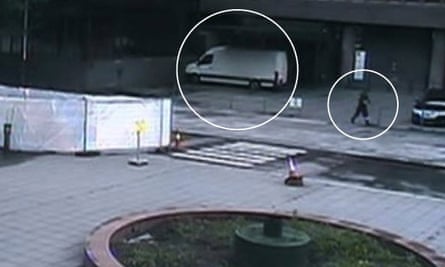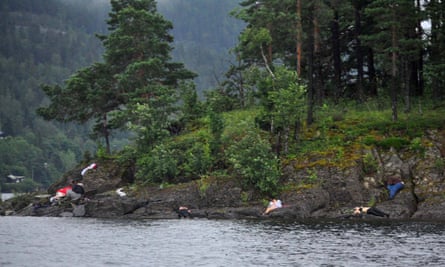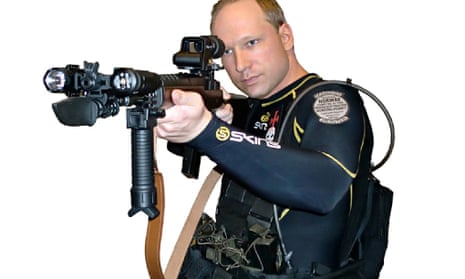At a quarter to three, Anders Breivik went out of his room, turned left, opened the front door and slammed it shut behind him. In the room, the computer and modem droned on. Once the manifesto had been sent to 1,000 email addresses, everything ground to a halt. The spam filter had detected that the upper limit for the number of messages that could be sent per day had been reached. On the screen, a window was open in the web browser. It showed the day’s programme for the AUF (Workers’ Youth League) on Utøya.
Down to the junction, along past the old industrial buildings of the electrical plant, past the bronze statue of a naked girl with her arms in the air. He briskly covered the ground on his usual route to the garden centre.
He unlocked the VW Crafter van and climbed into the back. Inside were the strong plastic bags from China in which he had packed the explosives. He got changed beside the bomb. Off came Ralph Lauren, Lacoste and Puma. He pulled the black compression top over his head and fixed the plastic police insignia on to the sleeves, then strapped on the bulletproof vest. He pulled on the black trousers with the reflective strips and fastened the pistol holster to his thigh. Lastly, he put on the heavy black boots with spurs at the heels.
Before opening the van door to get out, he looked round carefully. This was a moment of vulnerability. If anyone saw him getting out of the back of the van in full police uniform, they might start to wonder. But he saw nobody. Skøyen seemed deserted on that chilly grey Friday in July; most people round here were away at their summer cottages or holiday homes. He closed the back door, went round the side of the vehicle and climbed into the driver’s seat.
There were no barriers to prevent the van from driving right up to the 17-storey building that housed the Ministry of Justice and the prime minister’s office.
When he turned up towards the reception area, he saw that there were a couple of cars blocking the ideal place to park. To maximise the pressure wave in one direction he had packed the 950kg bomb so there were several hundred kilos more explosive on one side. The two cars would force him to park the other way round. The explosive force would blast outwards from the building, rather than into it.
The aim was to make the building collapse. He had calculated that if he managed to destroy the first row of the pillars holding up the building, the whole thing would come down: the prime minister’s office at the top and everything below it. He parked right outside the reception area, close to the building.
Fear was starting to take a grip. His hands were shaking. To try to suppress the fear and calm himself down he focused on the plan, which he had run over in his head hundreds of times. He had seen the sequence of events unfold in his mind over and over again. Now he had to rely on his training and stick to the plan.
He took out his lighter. His hands continued to shake. Still at the wheel, he turned and reached backwards to light the fuse protruding through the hole from the load compartment.
The fuse caught light immediately, emitting sparks. It crackled its way towards the bags of fertiliser. Now there was no way back. He had been braced to die the instant he lit the fuse. The Analfo gas could escape through the hole and make the van explode.
Slightly nonplussed when this did not happen, he grabbed his keys and got out, forgetting his mobile phone on the dashboard. He locked the car and looked round. Planning the operation, he had imagined that armed agents would come running up and he would have to kill them. But nobody came. He still undid the holster on his thigh, took out Mjølnir – he had named his Glock after Thor’s hammer – and crossed the road.
A few minutes after Breivik lit the fuse, one of the receptionists in the tower block informed security that there was a wrongly parked van outside the entrance. One of the guards rewound the film from the relevant camera back a few minutes and pressed play. He watched the images of a van slowly driving up and saw a uniformed man, whom he assumed to be a guard, leave the van and disappear from the screen.

They were used to illegal parking. According to the regulations, the reception parking area was only for the use of official cars collecting or dropping off the prime minister and his ministers. But the rule was not enforced.
Off camera, roadworks obliged the uniformed man to cross over to the opposite pavement. There he met a young man with a bunch of roses. The man gave the police officer a curious look and the pistol caught his eye.
Breivik swiftly weighed up whether the man in front of him was a security agent who would have to be shot. He decided he was a civilian and let him live.
The man with the roses was surprised to see the armed police officer get into a (second) delivery van. It was also rather odd that he drove out into Møllergata against the flow of traffic. In fact, so strange that he got out his mobile and tapped in the van’s make and registration number – Fiat Doblò VH 24605 – before he went on.
Down in the security control centre, the duty officer was using the cameras to try to locate the driver. But the cameras there revealed nothing. The guard switched his attention back to the illegally parked van and zoomed in on the number plate.
By then, Anders Breivik was already on his way out of Møllergata, where he turned right to drive down to the sea and into the Opera Tunnel, where the motorway ran under the fjord. He set the van’s GPS to the coordinates he had programmed in.
In the government quarter a man came up the little access way from Møllergata towards the fountain at Einar Gerhardsen’s Square. The young lawyer was not at work that day, but he had just finished a report on customs agreements between the EU and the developing world and wanted to show it to his team. “Just email it,” said his colleague in the legal department, but Jon Vegard Lervåg wanted to hand it over in person, so he could wish everybody a good summer holiday at the same time.
Vegard was 32, the same age as the man who was now on his way to the motorway tunnel. He had just got married, and over the weekend he and his young wife would be going home across the mountains to the coastal town of Ålesund to tell their parents the good news: they were expecting their first child.
As Jon Vegard came abreast of the van it exploded into a sea of flames. He was thrown sideways by a pressure wave so powerful that he was killed instantly, even before the splinters of glass and metal hit him.
The time was 15:25:22. Two young women, lawyers at the ministry who were standing behind the van, were also lifted into the air by the pressure wave, engulfed in the sea of flame and thrown to the ground. They, too, were killed instantly. Two receptionists in the tower block were thrown out of their seats, over the counter and out into the square. Glass blew into the building, doors were smashed, window ledges became jagged spears of wood and shards of metal red-hot knifepoints.
Everything was hurled either into the building or out over the square, street and fountain, where eight now lay dead or dying. Around them lay numerous injured people, knocked unconscious by the pressure wave, or with deep cuts.

Gently, almost floating in the wind, sheets of paper fluttered down over the scene of destruction. Fragments of Jon Vegard’s body flew through the air and spread along the facade of the tower block. Only one hand landed intact on the ground. On one of his fingers his wedding ring remained unscathed.
“What was that?” said the prime minister, Jens Stoltenberg. He was sitting at his desk, talking on the phone. That morning, he had decided to work from his residence in Parkveien, behind the royal palace. It was the holiday period and quiet, so there had been no need to go into the office in the tower block. He was preparing the speech he would be making on Utøya the next day.
When the bang came, he was on the phone to the president of the parliament, Dag Terje Andersen, who was in a forest down south. Thunder, thought the prime minister; the forecast was for stormy weather. They carried on talking.
A secretary from the prime minister’s office was in the reception area when the bomb went off. She was killed instantly by the pressure wave. Outside Stoltenberg’s door in the tower block lay one of his security guards, knocked unconscious, while the PM’s communications adviser ran out of his office on the 15th floor when the windows blew in. Blood was dripping on to his shoes. There was a deep gouge across the back of his head and blood was welling through his copper- coloured hair. He ran back into the wreckage of the office for something to staunch the bleeding. He found a T-shirt in a bag and pressed it to the wound.
As he ran down the stairs he rang the prime minister on his direct line. “Hi, it’s Arvid. Are you OK?”
“Yes,” said Stoltenberg. He still had Andersen on the other line.
“You’re not hurt?”
“No…”
As Arvid Samland made his escape down the partially dark, wrecked stairwell he told the prime minister what he could see. He and various other employees were trying to get out of the building.
There was smoke and thick dust everywhere, fallen masonry and fittings were blocking sections of the steps and splinters of glass covered the staircase where Picasso’s sand-blasted lines hung undamaged.
Beneath the block, the security guard rang the Oslo police, and was thus the first person to alert them to the explosion.
Meanwhile, hundreds of people were running away from the tower block. Smoke was gushing out of the building and several storeys were on fire; the building could collapse at any moment or there could be another explosion. Others just stood there gaping. Or they got out their phones and rang home.
The security guard who had alerted the police stayed in front of his screens. He found his way back to the pictures of the van that had parked six minutes earlier. As soon as he had viewed the recording again, he rang the police for a second time.
“It’s a vehicle that exploded,” he said, and told them about a man wearing a dark uniform who left the van minutes before it blew up.
Three guards came into the prime minister’s office in Parkveien, put him into a bulletproof vest and ordered him to follow them to a secure room. The fact that the attack in the centre had been directed at the government building meant it was possible the prime minister’s residence could also be a target.
Still, no armed guards were directed to protect the building.
Breivik had the radio on as he drove. He had not heard any blast. Something had gone wrong; the fuse had not detonated the explosives. It had failed!
The van should have blown up long since, he thought as the traffic came to a standstill in the Opera Tunnel.

He drove on. Turned up the radio. A few minutes later the broadcast was interrupted with the news that there had been an explosion in the government quarter.
Yes! It had gone off.
The first police car reached the scene three minutes after the explosion. Ten ambulances were also dispatched. Several passers-by stopped to give first aid. Oslo University Hospital was put on major incident alert and the accident and emergency department prepared for many admissions. Nine minutes after the explosion, a call came through on the police public hotline.
“Er, hello, Andreas Olsen here. I’m ringing because I saw something very suspicious as I was going past the government quarter.”
The operator said she could not take his tip-off then and there, and that it would be better if he called back. Olsen interrupted her and said he had observed a man in police uniform walking along with a pistol in his hand.
“This is a concrete lead about a car,” Olsen insisted. He was the pedestrian with the bunch of roses who had seen Breivik walking up from the government quarter. He gave a brief account of what he had seen: a man with a crash helmet and pistol, who had “something strange about him”. The man had left the area unaccompanied and got into a grey van with the registration number VH 24605.
The operator had just read the report from the security guard in the basement of the tower block, and put the two pieces of information together. She realised this was an important tip-off and noted it down on a yellow Post-it note.
She took the note with her to the joint operational centre and put it on the leader’s desk. Although the chief of operations was busy on the phone, the operator thought she had made eye contact with her.
Her impression was that the supervisor had registered that the note was important. She went out.
Untouched on the desk, in a room in chaos, the note did not disturb anyone.
The Oslo police district did not have any shared alert procedures, so the chief of operations started ringing staff members one by one. Instead of taking the lead at the joint operational centre and co-ordinating action, she gave priority to calling individual officers in for duty. In the acute phase there was hardly any contact between the chief of operations and the on-scene commanders.
Breivik was still in the queue to get into the Opera Tunnel. He was afraid the whole of Oslo was already shut off because of the bomb attack and that he would never get to the next phase of his plan.
Had he been the police chief, he would have blocked all the main arteries, he reasoned. But no roadblocks were set up, no roads were closed. It was not even considered. All available manpower was deployed to the government quarter.
None of the police on the streets were asked to look out for a Fiat Doblò delivery van with the registration number VH 24605, or a guard in a dark uniform in a civilian vehicle.
Breivik was still very close by. It took him a long time to get through the eastern city centre and the tunnel under the Oslofjord before he re-emerged at ground level in the western part of the centre.
From the Opera Tunnel he drove past the US embassy, which was now swarming with security personnel. The police had also taken up positions outside the embassy. He drove right past. Ha, they’ve assumed it’s Islamic terrorism, he thought. He amused himself listening to the terror experts on the radio saying the bombing pointed to al-Qaida.
The security mobilisation at the embassy pushed up his stress level a bit. He had to calm down. The crucial thing was not to crash. He passed the corner of the Royal Gardens, and Parkveien, where the prime minister was in a secure room. He drove past Fritzners gate, where he had lived in the very first years of his life. A few streets away was the flat he had rented in his 20s. He knew the streets here, the bars and the shops. He knew the escape routes and shortcuts. He now knew he would get out of the city; the police would never be able to close off all the roads to the west.
As time went on, there were more reports from members of the public who had observed a man in uniform leaving the van a few minutes before it blew up. The security guards in several ministry buildings viewed the CCTV tapes that showed the sequence of events from different angles. They provided a description identical to the one given by Andreas Olsen.
But no alerts were sent out from the joint operational centre at the police headquarters in Oslo, neither to the force itself nor to the public via the media.
At 15:55, half an hour after the bomb had gone off, an operator happened to see the yellow note lying on the unit leader’s desk.
Twenty minutes had passed since Andreas Olsen reported his information. Now, they rang him back and asked him to go through it all again.
Olsen confirmed the details of what he’d seen and gave a description: European appearance, in his 30s, about 1.80m tall. The operator became convinced this was an important lead.
“Good observation. What was the registration number of that car?” By the time they rang off, it was 16:02.
After the call, the operator marked the report as “important” in the operation log and made sure it was accessible to all. She also filled in the on-scene commander, who asked her to pass the report on to a patrol from the emergency response squad.
At 16:03, Breivik passed the police station in Sandvika, on the E18. If the officers had been looking out of the windows, they would have seen the silver-grey van driving past.
Sandvika had men ready and waiting, but did not know what to do with them and was awaiting a request for assistance from Oslo.

At 16:05 the operator in Oslo made a mobile phone call to the emergency response unit informing them of the man in a dark uniform driving a Fiat Doblò. She also gave them the registration number.
The patrol said the description was too vague for any action to be taken.
At 16:09 the chief of operations in Asker and Bærum, the district through which Breivik was now driving, finally got through to Oslo police district to offer assistance. She was informed about the van and the possible perpetrator. At that point in time, the station at Asker and Bærum had three patrol cars at its disposal; the chief of operations rang the closest one and gave the description. This patrol was on its way to Ila prison to pick up a prisoner who was to be taken to Oslo.
The chief of operations asked them to postpone the prisoner transport because of the bomb in Oslo.
She also alerted the two other patrols and read over the radio the type of vehicle and registration number. Then she once again contacted the patrol at Ila prison, which by then should have been free, and commanded it to go out on observation along the E18.
But the two policemen in the patrol car had chosen to ignore their orders. They had picked up the prisoner from the prison after all and were now on their way into Oslo. They had wanted to “get the job out of the way”, they said. Asker and Bærum’s second patrol had been busy with a psychiatric assignment and had been given orders to leave it. That order was not obeyed either.
To judge by the way the Oslo police were behaving, little indicated that Norway had just been the target of an act of terror, with an acute risk of secondary attacks. When other districts offered support, their offers were largely declined, even though many potential targets around Oslo remained unsecured. The parliament requested reinforcements as there were no armed officers outside the main building. You will have to make do with your own guards, the head of the Oslo operational centre informed them.
Norway owns a single police helicopter – and in July, the helicopter service was on holiday. As a consequence of new savings measures, there was no emergency crew cover at the height of the summer. The first pilot nonetheless reported for duty right after hearing about the bomb on the news. He was told he was not needed. Yet the emergency response unit requested use of the helicopter twice in the hour that followed.
The squad was informed that the helicopter was unavailable, even though it was on the Tarmac, fully operational and ready to fly. Nor did the police take any steps to mobilise military helicopters or make use of civilian helicopter companies.
The information provided by witnesses was not read out over any general communication wavelength, nor was it passed on to the media so that alerts could go out on radio and television.
The Public Roads Authority in Oslo, which has a comprehensive network of cameras, was not alerted either: despite the fact that the government quarter, Norway’s most important seat of power, had been blown to smithereens by a bomb, the terror-response plan was not implemented.
Meanwhile, Breivik drove calmly on towards Sollihøgda. He kept to the speed limit.
Soon, he would be able to see Utøya.
This is an extract from One Of Us, by Åsne Seierstad, published on 5 March. Everything in the book is based on testimony. All the scenes are constructed according to witnesses’ accounts. Any reference to Breivik’s thoughts and feelings are based on his own diary, his testimony in court, his answers during interrogation and his log in the manifesto. To order a copy of the book for £13.59, go to bookshop.theguardian.com
Follow the Observer Magazine on Twitter @ObsMagazine

Comments (…)
Sign in or create your Guardian account to join the discussion